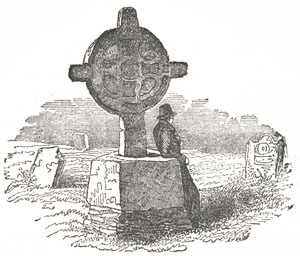The Saxon Invasion of Ireland

Cross at Finglas
Christianity improves the Social State of Ireland—A Saxon Invasion of Ireland—Domestic Wars—The English come to Ireland for Instruction—A Famine and Tempests—The First Danish Invasion—Cruelty of the Danes—The Black and White Gentiles—King Cormac Mac Cullinan—Cashel—Amlaff the Dane—Plunder of the Towns—Arrival of Sitric—Death of Nial Glundubh—The Circuit of Ireland—Malachy the Second—Entries in the Annals.
[A.D. 693—926.]

ERY few events of any special interest occur between the commencement of the seventh century and the Danish invasion. The obituaries of ecclesiastics and details of foreign missions, which we have already recorded, are its salient points. The wars of the Saxon Heptarchy and the Celtic Pentarchy almost synchronize, though we find several Irish kings influenced by the examples of sanctity with which they were surrounded, and distinguished for piety, while Charlemagne pronounces their neighbours a perfidious and perverse race, worse than pagans. There can be no doubt that Charlemagne's high opinion of the Irish was caused by the fact, that so many of the heads of his schools were of that nation, which was then in the vanguard of civilization and progress. The cloister, always the nursery of art, the religious, always the promoters of learning, were pre-eminent in this age for their devotion to literary pursuits. In the present work it is impossible to give details of their MSS. still preserved, of their wonderful skill in caligraphy, still the admiration of the most gifted, and of the perfection to which they brought the science of music; but I turn from this attractive subject with less regret, from the hope of being soon able to produce an Ecclesiastical History of Ireland, in which such details will find their proper place, and will be amply expanded.[3] The revolution of social feeling which was effected in Ireland by the introduction of Christianity, is strongly marked. Before the advent of St. Patrick, few Irish monarchs died a natural death—ambition or treachery proved a sufficient motive for murder and assassination; while of six kings who reigned during the eighth and ninth centuries, only one died a violent death, and that death was an exception, which evidently proved the rule, for Nial was drowned in a generous effort to save the life of one of his own servants.
The fatal pestilence, already recorded, did not appear again after its severe visitation, which terminated in 667. In 693 Finnachta Fleadhach (the Hospitable) commenced his reign. He remitted the Boromean Tribute at the request of St. Moling, and eventually abdicated, and embraced a religious life. In the year 684, Egfrid, the Saxon King of Northumberland, sent an army to Ireland, which spared neither churches nor monasteries, and carried off a great number of the inhabitants as slaves. Bede denounces and laments this barbarous invasion, attributing the defeat and death of King Egfrid, which took place in the following year, to the vengeance of heaven.[4] St. Adamnan was sent to Northumbria, after the death of this prince, to obtain the release of the captives. His mission was successful, and he was honoured there as the worker of many miracles.
Notes
[3] Expanded.—I take this opportunity of requesting from laymen or ecclesiastics who may read this announcement, the favour of any information they may consider valuable.
[4] Heaven.—Ec. Hist. lib. iv. c. 26. "From that time the hopes and strength of the English crown began to waver and retrograde, for the Picts recovered their own lands," &c. The Annals of the Four Masters mention a mortality among cattle throughout the whole world, and a severe frost, which followed this invasion: "The sea between Ireland and Scotland was frozen, so that there was a communication between them on the ice."—vol. ii. p. 291. They also mention the mission of Adamnan to "Saxon land."
